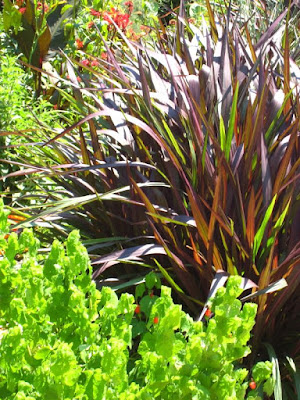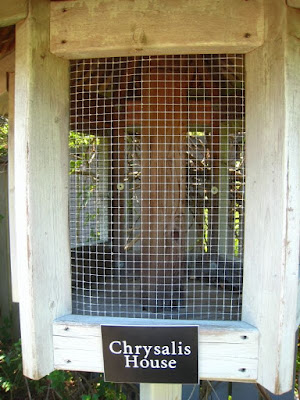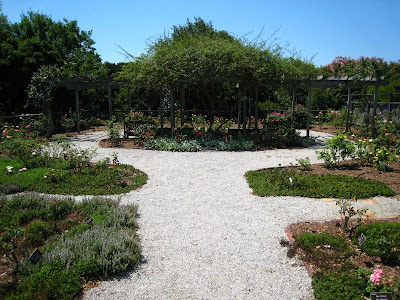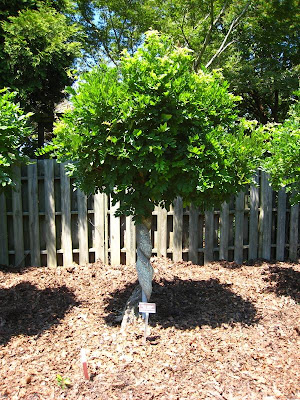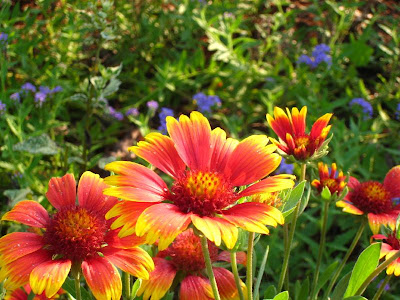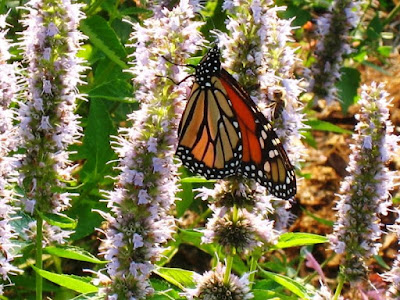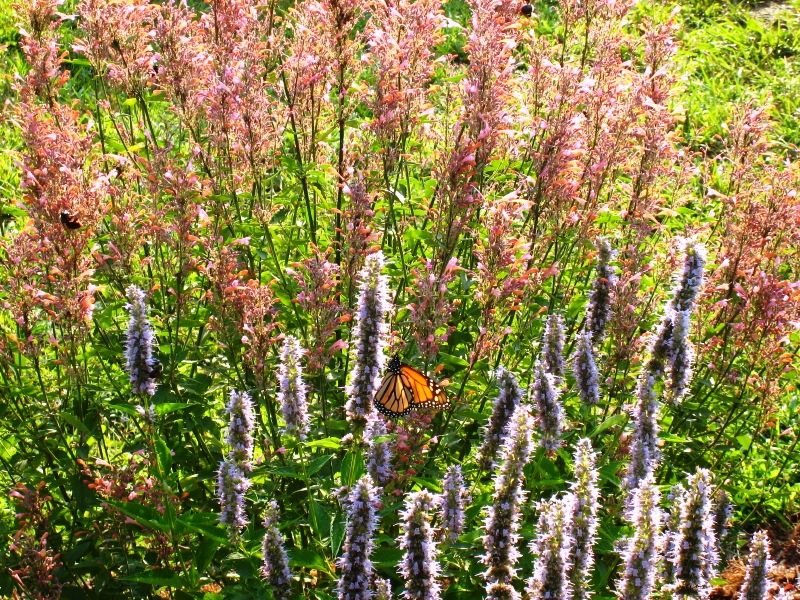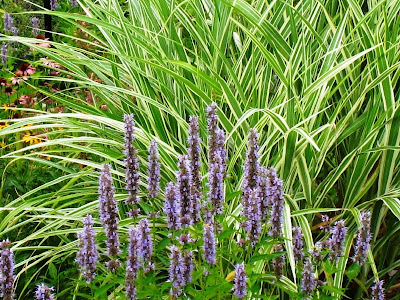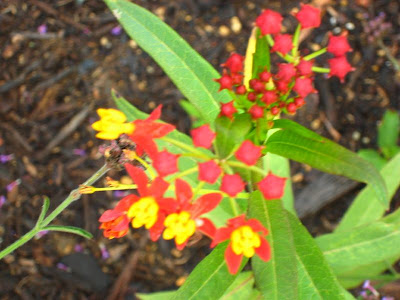
One of my biggest challenges in designing and planting a deer resistant flower garden was to make it colorful. At first, I felt so limited by my choices. Now, I feel like there are so many perennials, shrubs, bulbs, trees and ornamental grasses from which to choose to plant in a deer resistant garden.
The deer have been out and about the house and gardens a lot lately. We've seen a group of bucks, several does with twins and singles, and a lot of adolescent deer. A doe pretty much lives out her life in the same small area while a buck will traverse around a few miles from home. Since the slight Japanese iris bloom munching back in June when the fawns were born, I've not had any more damage in the garden. We've also been getting some good rain lately, so this was a great time to update my photographs so that I can keep a history of the garden at different times.
While most of the perennials in the next photo have finished blooming, the crape myrtle is in full bloom. I've never had any problem with deer munching a crape myrtle. Lagerstroemia come in all sizes and many colors. The Japanese Beetles will munch our little shrub-size lagerstroemia 'White Chocolate', but they tend to leave the larger trees like this 'Tuscarora' alone.

In the next photo, echinops 'Ritro' (globe thistle) is starting to bloom. The burgundy foliage is that of the crape myrtle 'White Chocolate' that should bloom soon. Just to the right of the myrtle is a rosemary and the echinacea 'Ruby Star' (coneflowers). I've not had any munching of those coneflowers this year. The pale blue spires to the upper left are agastache 'Blue Fortune' (hummingbird mint).

This is another view of that clump of coneflowers, taken from the ground down the slope looking up the slope. There is Heliotropium amplexicaule 'Azure Skies' (creeping perennial heliotrope) at the feet of the flowers. I use heliotrope extensively throughout my garden as it is a fast-growing perennial groundcover that is literally loaded with blooms throughout summer until frost.
In the foreground is Eupatorium coelestinum Wayside (perennial ageratum) that grows in the lower, moist soil at the bottom of the slope. I've seen just a few samples taken on the ageratum, so I don't think the deer liked it. The samples were clean-cut, so it could have been a rabbit taking a taste. These coneflowers are also grouped with spirea 'Neon Flash' a little shrub that blooms a deep rose color. It was deadheaded a few weeks ago and is about to bloom again.

Here's an earlier photo of spirea 'Neon Flash' when it was in bloom:

Another clump of the same coneflowers are grouped with monarda 'Blue Stockings' (bee balm). Bee balm is totally deer proof. Rabbits leave it alone, too. Hummingbirds love it as do the honeybees. In fact, it's difficult for me to deadhead the bee balm because of all of the honeybees!
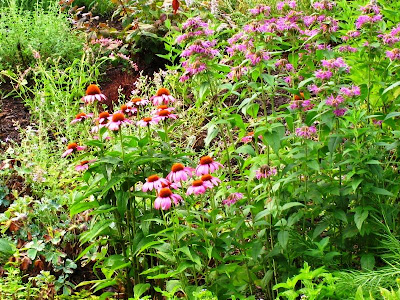

I'm still trying to decide what companions will look good with the next photo of salvia ulignosa (bog salvia). The blue is so pure that I think it needs some yellow or white companions. That said, one plant is all you need as it sends out runners...give it a lot of space and plan to pull out what you don't want! At the end of everyday, it looks like the blooms are spent, only to be blooming great again the next morning! The honeybees and hummingbirds love this plant and the deer leave it alone, so it's staying for now.


Speaking of hummingbirds, Salvia guaranitica 'Black and Blue' is a favorite as you can see from my little friend, a female Ruby-throated hummingbird. The deer don't bother this salvia at all, so plant a lot if you've got the right conditions! The dark blue flowers look great with a lot of other colors -- yellow, white, red, orange.


This agastache Acapulco 'Salmon and Pink' is another hummingbird favorite. This fragrant agastache blooms non-stop and is ignored by deer, rabbits and other pests. I have clumps of this that are 3 feet high and almost as wide. It's easy to divide in the spring so you can use this liberally. This weekend, I took a small clump of this and moved it closer to the 'Ruby Star' echinacea. I've been cutting off some of these blooms and walking around the garden to look for more ways to use this in my color schemes. It looks good with blue, deep rose, yellow and orange blooms.

Here you can see the same agastache mixed with all colors in the butterfly garden. The small tree is a vitex; the variegated ornamental grass is miscanthus 'Cosmopolitan'. The garden also includes salvia, yarrow, hypericum, orange coneflowers, tithonia 'Fiesta del Sol' (an annual), rudbeckia 'Goldsturm' (some munching by deer/rabbits on the rudbeckia, so you can see the little fence around it on the lower left side).

I'd like to work my design so that I can place the agastache 'Salmon and Pink' close to lantana 'Ham and Eggs' (shown here close up). While this lantana is supposed to grow only 2 feet high, mine are literally big shrubs about 4 feet high and wide! Lantana is another deer proof, rabbit proof, drought tolerant plant. This one must wait until spring to cut back the deadwood. As such, it can look rather ghastly over the winter, but gloriously blooms all summer until frost, so I put up with it. It's also a butterfly magnet!

This agastache 'Coronado' is new this year, planted as a tiny seedling in the spring. It is a pale orange/yellow, almost apricot color. I have high hopes for it to provide a big mass of color like the 'Salmon and Pink'. If it performs well, I've got to put this one with a salvia 'Black and Blue'. When it comes to deer, plant all the agastache you want!

Agastache 'Blue Fortune' is another reliable for the deer resistant garden. The pale spikes last all summer long and it is also a favorite for the good characters in the garden...hummingbirds, honeybees and butterflies.

Crocosmia 'Lucifer' is a red shown here with some new asclepias (red and orange milkweed), and verbena bonarisensis (tall verbena), and salvia gregii 'Navajo Red' in the background down the hill. All of these are deer proof plants.

This is a brand new crocosmia 'Jenny Bloom' that I just planted on Saturday to bring in some gold color. The crocosmias benefit from being dug up and replanted each year as the corms (think: bulbs) tend to grow in a stack and you'll get fewer blooms unless you adjust them a bit. I think they're worth it! This is a Bressingham Gardens (United Kingdom) variety.

This is also a gold/yellow plant. It doesn't look like much right now since it was just planted (4" pot), but this cestrum 'Orange Peel' (night blooming jasmine) is reported to bloom from June until frost here, growing in size up to 6 feet high and wide. It's supposed to be fragrant in the evenings. I'm looking forward to watching this one flourish in my garden. It is reported that all parts are toxic, so take that into consideration if you have children.

Salvia gregii 'Navajo Red' (there's some debate over whether this is the right name) is a great performer in my garden that is loved by hummingbirds and ignored by deer and rabbits. It's a pretty red for the garden. It mixes well with deep blues and bright yellows. I'd like to do more with this one, but it's difficult to find. I can think of so many color combinations that I'd like to create around it.


I have to include lavender as a deer proof, rabbit proof perennial herb. It's colorful, it's beautiful, it's drought tolerant. It's low maintenance (sheer it back a bit after bloom and again in late winter). About the only thing that kills it is too much water or not sheering it back every year. It will get ugly and woody if you don't sheer it back to keep the stems flexible and pretty. Pick a variety that works in your area. If you love lavender, you might want to try to grow some for cooking or for making your own bath products. I made lavender scones recently and they are delicious! I bought culinary lavender from a local farm (see my earlier blog). Some lavenders are purely ornamental, like the Spanish lavender (1st photo below) that blooms in spring. The Munstead lavender (2nd photo below) blooms in the summer. Provence, Hidcote, Grosso, Goodwin Creek are other varieties with special uses. I just planted three new Provence lavenders this weekend to use for culinary purposes.


I'd be totally negligent if I didn't mention nepeta! I've written an entire blog article around this one perennial. While I have several varieties in the garden, and I use it throughout the garden, it is deer resistant, rabbit resistant, drought tolerant, and it is colorful. Here, it is shown blooming with Dutch irises, also deer resistant. This photo was taken in April, but nepeta has a very long bloom time. Sheer the blooms and it blooms again.

I've also written about buddleia in my garden. I have many of these shrubs that are of different size, different colors....5 feet high, 7 feet high. Blue, purple, yellow, pink, etc. Pick one that you like and the deer won't eat it.




As you can see, there are many colors available for a deer resistant garden! I've just really shown you a little slice of choices. If you visit my other blogs, you may find other color combinations that work in the deer resistant garden. Some day, I'll put together an index with plant information and photos...someday when I have the time to undertake that big task! :-)
Happy Gardening!
Cameron










